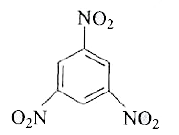Both N(SiH3)3andNH(SiH3)2 compounds have trigonal planar skeleton. Incorrect statement about both compounds is :
SiNSi bond angle in NH(SiH3)2>SiNSi bond angle in N(SiH3)3)
N−Si bond length in NH(SiH3)2>N−Si bond length in N(SiH3)3)
N−Si bond length in NH(SiH3)2<N−Si bond length in N(SiH3)3)
Back bonding strength in NH(SiH3)2> Back bonding strength in N(SiH3)3)
The correct Answer is:B
To solve the problem regarding the compounds N(SiH3)3 and NH(SiH3)2 and identify the incorrect statement about them, we will analyze the structures and bonding characteristics of both compounds step by step.
Step 1: Understand the Structures
1. Compound 1: N(SiH3)3
- This compound has a nitrogen atom bonded to three SiH3 groups.
- The nitrogen has a lone pair of electrons, which can participate in back bonding with the silicon atoms.
- The geometry around the nitrogen is trigonal planar due to the three SiH3 groups and the lone pair.
2. Compound 2: NH(SiH3)2
- This compound has a nitrogen atom bonded to one hydrogen atom and two SiH3 groups.
- Similar to the first compound, the nitrogen can also engage in back bonding with the silicon atoms.
- The geometry around the nitrogen is also trigonal planar.
Step 2: Analyze Bonding and Angles
- Back Bonding: In both compounds, back bonding occurs between the lone pair on nitrogen and the vacant p-orbitals of silicon. This back bonding stabilizes the structure and influences bond angles.
- Bond Angles: The bond angles in both compounds are expected to be approximately 120 degrees due to the trigonal planar arrangement.
Step 3: Evaluate the Statements
We need to evaluate the statements provided in the question.
1. Statement A: The Si-Si bond angle in NH(SiH3)2 is greater than the Si-Si bond angle in N(SiH3)3.
- This statement is correct because the back bonding in NH(SiH3)2 is distributed among two SiH3 groups, leading to stronger bond angles.
2. Statement B: The N-Si bond length in NH(SiH3)2 is greater than the N-Si bond length in N(SiH3)3.
- This statement is incorrect. The bond strength due to back bonding is greater in N(SiH3)3 because the lone pair is shared among three SiH3 groups, resulting in a shorter N-Si bond length.
3. Statement C: The N-Si bond length in N(SiH3)3 is less than the N-Si bond length in NH(SiH3)2.
- This statement is correct and aligns with the explanation above.
4. Statement D: The back bonding strength in NH(SiH3)2 is greater than in N(SiH3)3.
- This statement is correct as the back bonding is stronger in N(SiH3)3 due to the involvement of three SiH3 groups.
Conclusion
The incorrect statement about both compounds is Statement B.
1. Compound 1: N(SiH3)3
- This compound has a nitrogen atom bonded to three SiH3 groups.
- The nitrogen has a lone pair of electrons, which can participate in back bonding with the silicon atoms.
- The geometry around the nitrogen is trigonal planar due to the three SiH3 groups and the lone pair.
- This compound has a nitrogen atom bonded to one hydrogen atom and two SiH3 groups.
- Similar to the first compound, the nitrogen can also engage in back bonding with the silicon atoms.
- The geometry around the nitrogen is also trigonal planar.
- Back Bonding: In both compounds, back bonding occurs between the lone pair on nitrogen and the vacant p-orbitals of silicon. This back bonding stabilizes the structure and influences bond angles.
- Bond Angles: The bond angles in both compounds are expected to be approximately 120 degrees due to the trigonal planar arrangement.
We need to evaluate the statements provided in the question.
- This statement is correct because the back bonding in NH(SiH3)2 is distributed among two SiH3 groups, leading to stronger bond angles.
- This statement is incorrect. The bond strength due to back bonding is greater in N(SiH3)3 because the lone pair is shared among three SiH3 groups, resulting in a shorter N-Si bond length.
- This statement is correct and aligns with the explanation above.
- This statement is correct as the back bonding is stronger in N(SiH3)3 due to the involvement of three SiH3 groups.
The incorrect statement about both compounds is Statement B.
Topper's Solved these Questions
- CHEMICAL BONDING (ADVANCED)BOOK - VK JAISWAL ENGLISHCHAPTER - CHEMICAL BONDING (ADVANCED)EXERCISE - Level 3
77 Videos
- CHEMICAL BONDING (ADVANCED)BOOK - VK JAISWAL ENGLISHCHAPTER - CHEMICAL BONDING (ADVANCED)EXERCISE - ONE OR MORE ANSWER IS/ARE CORRECT
78 Videos
- CHEMICAL BONDING (ADVANCED)BOOK - VK JAISWAL ENGLISHCHAPTER - CHEMICAL BONDING (ADVANCED)EXERCISE - SUBJECTIVE PROBLEMS
64 Videos
- CHEMICAL BONDING (BASIC)BOOK - VK JAISWAL ENGLISHCHAPTER - CHEMICAL BONDING (BASIC)EXERCISE - SUBJECTIVE PROBLEMS
54 Videos
Similar Questions
Knowledge Check
Which of the following statements about a compound is incorrect ?
AA molecule of a compound has atoms of different elements.BA compound cannot be separated into its constituent elements by physical methods of separation.CA compound retains the physical properties of its constituents elements.DThe ratio of atoms of different elements in a compound is fixed.Which of the statements are incorrect about the following compound?
 AAll three C-N bonds are of same lengthBC1−NandC3−N bonds are of same length but shorter than C5−N bondCC1−NandC5−N bonds are of same length but longer than C3−N bondDC3−NandC3−N bonds are of different length but both are longer than C5−N bond
AAll three C-N bonds are of same lengthBC1−NandC3−N bonds are of same length but shorter than C5−N bondCC1−NandC5−N bonds are of same length but longer than C3−N bondDC3−NandC3−N bonds are of different length but both are longer than C5−N bond
Incorrect statement regarding BF3NH3 molecule is :
View SolutionAl2(SO4)3+NH4OH→X
Select the correct statement(s) about compound X:
View SolutionWhich of the following statements about the interstitial compounds is incorrect?
View SolutionTrisilyamine (SiH3)3 N is
View SolutionAssertion Both NOΘ3 and CO2−3 ions are triangular planar
Reasoning Hybridisation of central atom in both NOΘ3 and CO2−3 is sp^(2) .
View SolutionThe compound (SiH3)3N is expected to be
View Solution